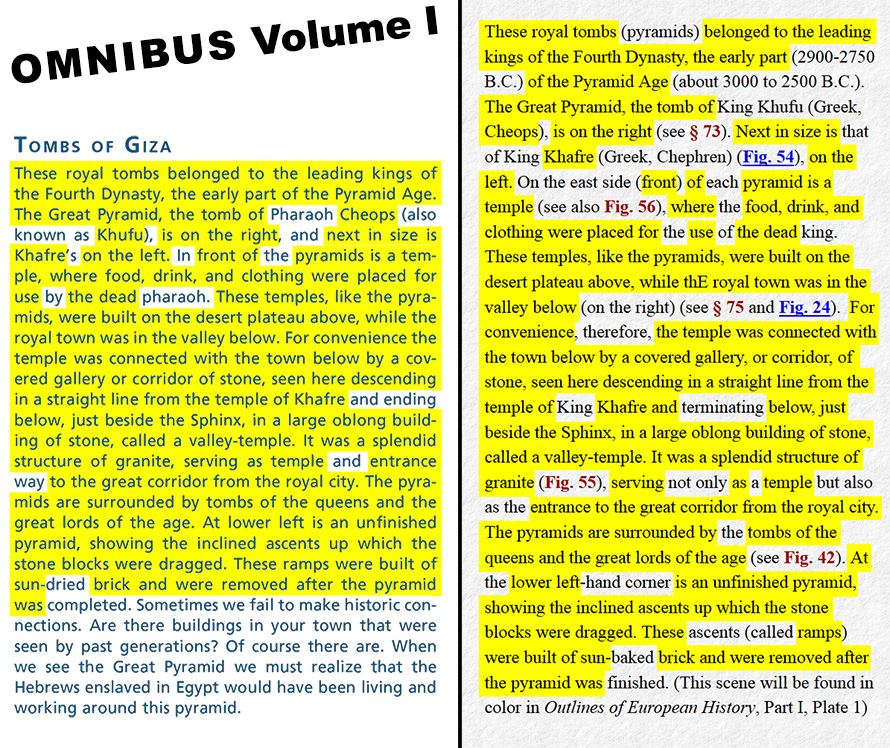“And a controversy about alleged plagiarism in the Omnibus textbooks just occurred. . . . The process used by [Rachel] Miller to tag such problems is unreliable, and is prone to false positives. If Wikipedia says “Columbus discovered America in 1492,” we are not much edified by a color coded America was discovered in 1492 by Columbus. . . . Since Wikipedia is constantly changing, we will have a hard time determining what came from what. In other words, did an Omnibus contributor lift something from Wikipedia in 2005, or did an Omnibus graduate contribute to a Wikipedia article in 2012?” DOUGLAS WILSON
Today we continue our examination of the 70+ images that Rachel Miller uploaded to her website to demonstrate wholesale plagiarism in the Omnibus textbook series. Pastor Doug Wilson of Christ Church, Moscow, dismissed Rachel’s findings as “alleged plagiarism” and “false positives”; and he floated the theory that an “Omnibus graduate contribute[d] to a Wikipedia article in 2012,” to account for some of the word-for-word plagiarism in the six textbooks he edited.
With these arguments in mind, please consider the example below, which I lifted from Rachel Miller’s blog with her permission:

The highlighted text on the left is taken from page 30 of Omnibus I: Biblical and Classical Civilizations1 and the highlighted text on the right was taken from dabar.org, an apologetics website. A cursory glimpse of the side-by-side text rules out the possibility of a so-called “false positive.” This is not a case of “America was discovered in 1492 by Columbus.” A cursory glimpse also eliminates the possibility of “alleged plagiarism.” The Omnibus editors cut and pasted 189 words from dabar.org into their word processor without citing their source, thus creating the impression they wrote the vignette. And they stole the image of the pyramids (see below) without which the copy makes no sense.
Since dabar.org is not an open-source site, we may rule out the possibility that an Omnibus graduate drew the sketch, wrote the content, and uploaded the material to the web. And since this screengrab is dated January 18, 2001, we may conclude that dabar.org predates the 2005 Omnibus by four years. The Omnibus editors stole this text.
Last, the Christians at dabar.org credited the source for their content: A History of the Early World2 by James Henry Breasted (1865–1935). He was a genuine scholar who loved his discipline. According to Wiki, Dr. Breasted was the first American to earn a Ph.D. in Egyptology and “His grave site is marked with a large Aswan granite cube, marked simply with his name and ‘historian and archaeologist.’”
No one will ever say that about the Omnibus editors.

1 Eds. Douglas Wilson & Tyler Fischer (Lancaster, PA: Veritas Press, 2005).
2 Boston, MA: The Athenæum Press, 1916. You can download a pdf of the book here. Scroll to page 56 to see the original source.

I’m thinking they need to try the “infinite monkey theorem” as a defense. Where if you had an infinite number of monkeys typing they would eventually reproduce Shakespeare. In this case the monkeys produced the Omnibus.
Well, you got the “infinite monkeys” part right anyway.
Rachel, you are on the money! There is a great 1984 cult film called Buckaroo Banzai that I haven’t seen in years so I can’t honestly say it is as good as I remember it to be. There is a great line in the film that I used to threaten my sons (tongue in cheek) with. . . . “Laugh while you can Monkey Boy.” Now that you have helped to identify exactly what and who we are dealing with this promises to be a boat load of fun.
Rose Huskey
“SHUT UP JOHN BIGBOOTE YOU COWARD, YOU ARE THE WEAKEST INDIVIDUAL I EVER KNOW”
This is what I imagine Doug Wilson’s sermons sound like:
https://youtu.be/pd56CIFSMI4
Rose, Thanks for the reminder of one of the best movies ever, and yes, Dash, that is exactly how I imagine a DW sermon is in real life.
Misquoting from a PA announcement: “Laphroaig is no longer available on credit.”
My favorite part is how the only original content is also non-factual http://web.stanford.edu/group/wais/Egypt/egypt_whobuiltpyramids9601.html .